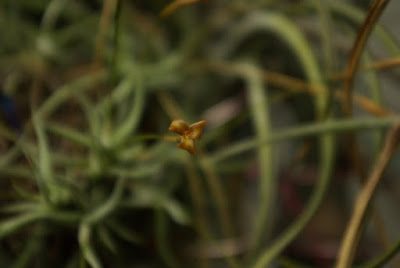Tillandsia rectangula is native from central Bolivia along the Andean borders spreading into the Argentinian Province of San Luis. It grows as epiphyte of the thorn shrub vegetation in highlands 700-1100 meters, and climbing to almost 2500 meters in Bolivia.
Tillandsia rectangula is a species of the genus Tillandsia. This species was described by John Gilbert Baker in 1878.
IDENTIFY TILLANDSIA RECTANGULA AIR PLANT
Tillandsia rectangula is native from central Bolivia along the Andean borders spreading into the Argentinian Province of San Luis. It grows as epiphyte of the thorn shrub vegetation in highlands 700-1100 meters, and climbing to almost 2500 meters in Bolivia.
It is a small epiphytic, 5-7 cm long, caulescent species, very branched, forming small dense tufts with small, rather numerous, distichous, to 20 mm long, leaves despite their polystic appearance (because of the twisting of the stem). The sheaths are glabrous and nested, sometimes veined. The limbs are triangular, twisted, more or less apart / bent, covered with dense scales.
This air plant blooms from the simple inflorescence, with a small spike carrying a single flower. The bracts of the flowering stem re few, glabrous, slightly veined. The floral bracts similar to the highest bracts of the flowering stem. The flowers are erect, almost sessile, non-tubular, 1.5 cm long. The flowers are yellow or orange. Sepals equally almost free, glabrous, lanceolate to ovate lanceolate, 5-7-nerved. Petals acuminate or rounded, entire edged or with light wavy edges with raphides, 5-7-nerved, yellow brown to brown, often with yellowish flecks or with yellowish edges, rolled back. The stamens and pistil are included.
TILLANDSIA RECTANGULA AIR PLANT CARE AND CULTURE
Cultural information should only be used as a guide, and should be to be adapted to suit you. Your physical location; where you grow your plants, how much time you have to devote to their care, and many other factors, will need to be taken into account. Only then can you decide on the cultural methods that best suit you and your plants.
Light:
Tillandsia rectangula requires good light and enjoys full sun (avoid the afternoon in summer if the plant is young or has not been used).
Temperature:
The required temperature ranging from 10 to 32°C. Get it early enough in the fall if you grow it outside, so that it does not face night temperatures below 4 or 5 ° C, especially if it is wet. The plants can faced temperatures close to 0 ° C (sheltered and dry) for a few hours without damage.
Humidity:
This air plant need the moderate level of humidity. Good aeration is required, the plant must dry quickly (in less than an hour).
Substrate, growing media and repotting:
Tillandsia rectangula refer to be mounted on a solid substrate that does not retain water. Place the plant very close to a window indoors in the winter and preferably outside the summer in sunny or partial shade. You can glue the plant directly to the surface with a strong adhesive, or you can wire the plant to the base. Don't cover the base of the plant with moss or it may rot. It can be grown on almost any imaginable decorative mount, including shells, rocks, slate, driftwood, etc.
Watering:
Two or three times a week in summer, once or two times a week in winter according to the luminosity and the ambient humidity. Obviously when it rains and if you grow it outside, it counts as a watering.
Fertilizer:
This air plant can be fertilized with the moderate doses. 1 to 2 times a month in the summer and 1 time a month in the winter.















COMMENTS